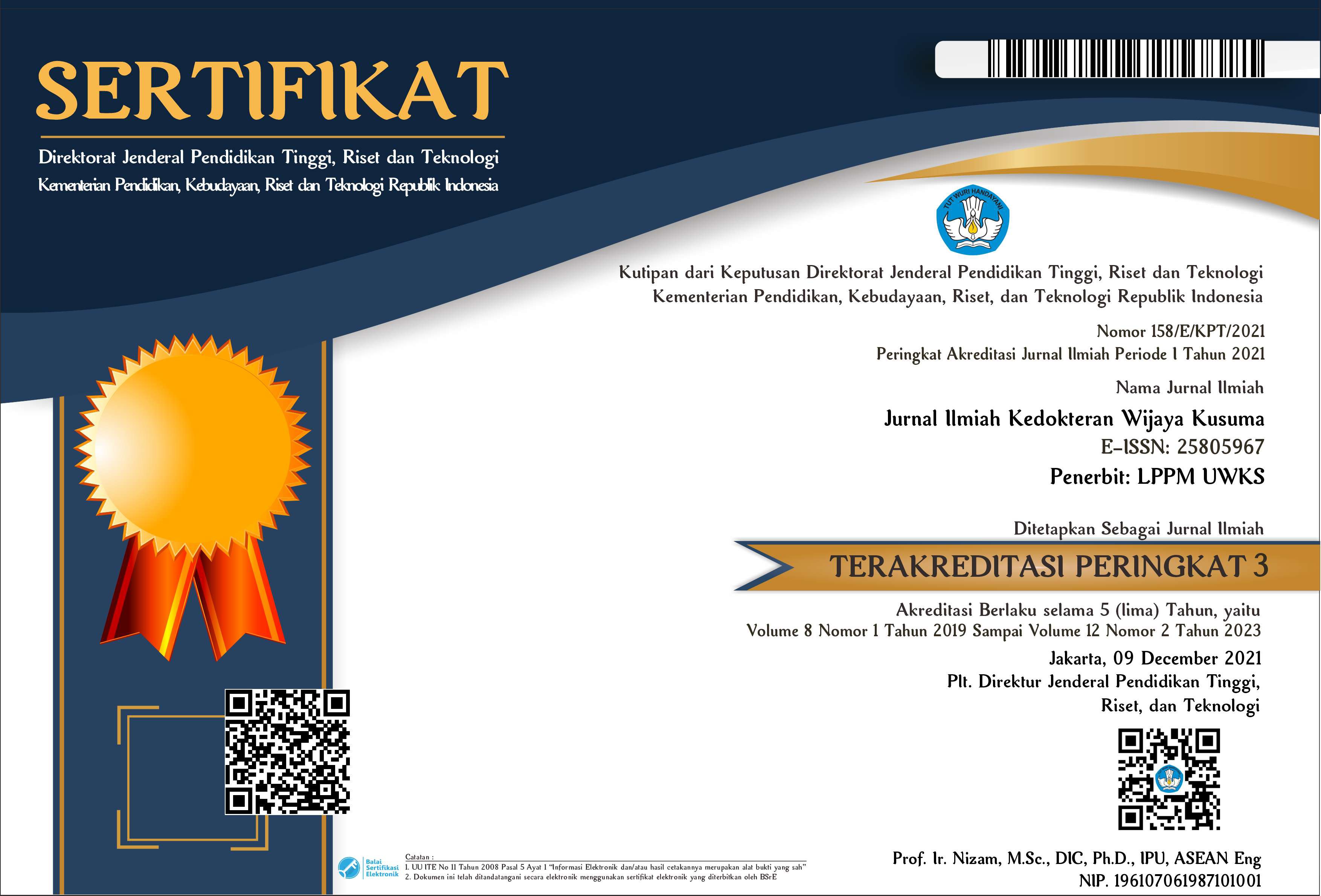Pengaruh Ekstrak Tamarindus indica Terhadap Kenaikan Berat Badan Pada Tikus Rattus norvegicus Yang Diberi Diet Obesitas
DOI:
https://doi.org/10.30742/jikw.v6i1.321Keywords:
fatty acid synthase, Tamarindus indica, weight gainAbstract
Obesity is a health problem whose prevalence tends to increase in Indonesia. Obesity becomes a concern, because it is one of the parameters that often followed by impaired of glucose tolerance in the metabolic syndrome. In Indonesia, Tamarindus indica is believed as a body slimming substance so it has possibility to become an alternative therapy that is easily available and cheap for obesity. The purpose of this study was to determine the ability of Tamarindus indica in inhibiting obesity. This experiment used 28 male Wistar strains in 2-3 months age that were divided into groups: group 1 (negative control, normal diet without Tamarindus indica), group 2 (positive control, obese diet without Tamarindus indica), group 3 (obese diet + Tamarindus indica 2700mg/kg BW), and group 4 (obese diet + Tamarindus indica 3600mg/kg BW). Measurement were performed in the first day after acclimization before treatment (day 8), and repeated weekly afterwards, ie at day 15, 22, 29, 36, and 43. Anova and Tukey Simultaneous statistics test were performed to see the differences in wight gain per week compared with the first week of study, then compared between groups. Furthermore, a virtual screening that called insilico bioinformatics analyzes was performed to test the binding activity between quercetin and rutin (compounds in Tamarindus indica) with fatty acid synthase, an enzym that plays a role in de novo synthesis of fatty acids. Tamarindus indica was shown to significantly inhibit weight gain in rats with obese diet food (P=0.000), but differences dose of Tamarindus indica did not appear to have significant effect to inhibit obesity (P=0.321). The ability of Tamarindus indica is due to the compounds quercetin and rutin, where these two ingredients estimated to have the ability to inhibit fatty acid synthase with high strength.
References
Rasouli N and Kern PA. 2008. Adipocytokines and the Metabolic Complication of Obesity. J Clin Endocrinol Metab 93(11 Suppl 1): S64-S73
Riset Kesehatan Dasar (Riskesdas). 2013. Badan Penelitian dan Pengembangan Kesehatan Kementrian Kesehatan RI. Available from http://www.depkes.go.id/resources/download/general/Hasil%20Riskesdas%202013.pdf
Kassi E, Pervanidou P, Kaltsas G, Chrousos G. 2011. Metabolic Syndrome: Definitions and Controversies. BMC Medicine 9:48
Ranjan D, Swarup D, Patra RC, Chandra V. 2009. Tamarindus indica L. and Moringa oleifera M. Extract Administration Ameliorates Fluoride Toxicity in Rabbits. Indian Journal of Experimental Biology Vol 47 pp 900-90
Soemardji AA. 2007. Tamarindus indica L. or “Asam Jawaâ€: The Sourbut Sweet and Useful. Available from www.inm.u-toyama.ac.jp/jp/nennpo/07nennpo/07review_article.pdf
Amir M, Mujeeb M, Ahmad S, Akhtar M, Ashraf K. 2013. Design expert-supported development and validation of HPLC method: An application in the simultaneous estimation of quercetin and rutin in Punica granatum, Tamarindus indica and Prunus domestica. Pharmaceutical Methods 4 (2013) 62-67
Sippel KH, Vyas NK, Sankaran B, Quiocho FA. 2014. Crystal Structure of the Human Fatty Acid Synthase Enoyl-Acyl Carrier Protein-Reductase Doman Complexed with Triclosan Reveals Allosteric Protein-Protein Interface Inhibition. THE JOURNAL OF BIOLOGICAL CHEMISTRY, Vol 289, No 48, pp 33287-33295
Ukwuani AN, Abukakar MG, Shehu RA, Hassan LG. 2008. Antiobesity Effect of Pulp Extract Tamarindus indica in Albino Rat. Asian Journal of Biochemistry 3(4) pp 221-228
Azman KF, Amom Z, Azlan A, Esa NM, Ali RM, Shah ZM, Kadir KKA. 2011. Antiobesity Effect of Tamarindus indica L. Pulp Aqueous Extract in High-Fat Diet-Induced Obese Rats. J Nat Med
Jindal V, Dhingra D, Sharma S, Parle M, Harna RK. 2011. Hypolipidemic and Weight Reducing Activity of the Ethanolic Extract of Tamarindus indica Fruit Pulp in Cafeteria Diet- and Sulpiride-induced Obese Rats. Journal of Pharmacology and Pharmacotherapeutics Vol 2 issue 2 pp 80-84
Iftekhar ASMM, Rayhan I, Quadir MA, Akhteruzzaman S, Hasnat A. 2006. Effect Of Tamarindus indica Fruits On Blood Pressure And Lipid-Profile In Human Model: An In Vivo Approach. Pak. J. Pharm. Sci. Vol.19(2), 125-129
Currie E, Schulze A, Zechner R, Walther TC, Farese RV. 2103. Cellular Fatty Acid Metabolism and Cancer. Cell Metabolism 18:153-161
Liu H, Liu Y, Wu X and Zhang J. 2010. Biochemistry, Molecular Biology, and Pharmacology of Fatty Acid Synthase, an Emerging Therapeutic Target and Diagnosis/Prognosis Marker. Int J Biochem Mol Biol 1(1):69-89
Downloads
Published
Issue
Section
License
The journal operates an Open Access policy under a Creative Commons Attribution-NonCommercial 4.0 International License. Author continues to retain the copyright if the article is published in this journal. The publisher will only need publishing rights. (CC-BY-NC 4.0)

















